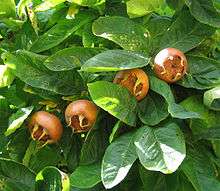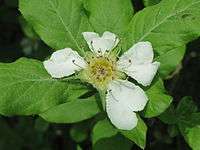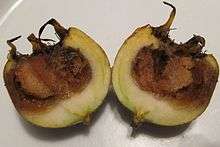Mespilus germanica
| Mespilus germanica | |
|---|---|
 | |
| Foliage and fruit | |
| Scientific classification | |
| Kingdom: | Plantae |
| (unranked): | Angiosperms |
| (unranked): | Eudicots |
| (unranked): | Rosids |
| Order: | Rosales |
| Family: | Rosaceae |
| Genus: | Mespilus |
| Species: | M. germanica |
| Binomial name | |
| Mespilus germanica L. | |
Mespilus germanica, known as the medlar or common medlar, is a large shrub or small tree, and the name of the fruit of this tree. The fruit has been cultivated since Roman times, and is unusual in being available in winter, and in being eaten when bletted. It is eaten raw and in a range of dishes. When the genus Mespilus is included in the genus Crataegus, the correct name for this species is Crataegus germanica Kuntze.
Origins and related species
Despite its Latin name, which means German or Germanic medlar, it is indigenous to southwest Asia and also southeastern Europe, especially the Black Sea coasts of Bulgaria and of modern Turkey. It may have been cultivated for as long as 3000 years.[1] The ancient Greek geographer Strabo refers to a μέσπιλον (mespilon) in Geographica, book 16, Chapter 4.[2]


Until recently, Mespilus germanica was the only known species of medlar. However, in 1990, a new species was discovered in North America, now named Mespilus canescens. The loquat, Eriobotrya japonica, is more distantly related than genera such as Crataegus, Amelanchier, Peraphyllum, and Malacomeles,[3] but was once thought to be closely related, and is still sometimes called the 'Japanese medlar'.
From an extensive study of literature and plant specimens, Kazimierz Browicz concluded that the[1]
true homeland [of Mespilus germanica] is only in the south-eastern part of the Balkan peninsula, in Asia Minor, on the Caucasus, Crimea, northern Iran and possibly also in Turkmenia.
Description and ecology
Mespilus germanica requires warm summers and mild winters and prefers sunny, dry locations and slightly acidic soil. Under ideal circumstances, the deciduous plant grows up to 8 metres (26 ft) tall. Generally, it is shorter and more shrub-like than tree-like. With a lifespan of 30–50 years, the medlar tree is rather short-lived. Its bark is greyish brown with deep vertical cracks forming rectangular plates that tend to lift off. The leaves are dark green and elliptic, 8–15 centimetres (3.1–5.9 in) long and 3–5 centimetres (1.2–2.0 in) wide. The leaves are densely hairy (pubescent) below, and turn red in autumn before falling. It is found across Southern Europe where it is generally rare. It is reported to be naturalized in some woods in Southeast England, but is found in few gardens.[4]
The flowers have five broadly ovate white petals.[4] The flowers appear in late spring, are hermaphrodite, pollinated by bees, and self-fertile.[5] The flower is 6 centimetres (2.4 in) wide. The reddish-brown fruit is a pome, 2–3 centimetres (0.79–1.18 in) diameter, with wide-spreading persistent sepals around a central pit, giving a 'hollow' appearance to the fruit.[4]
Cultivation and uses

The medlar was already being cultivated about three thousand years ago in the Caspian Sea region of northern Iran and Azerbaijan. It was introduced to Greece around 700 BC, and to Rome about 200 BC. It was an important fruit plant during Roman and medieval times. By the 17th and 18th centuries, however, it had been superseded by other fruits, and is little cultivated today. M. germanica pomes are one of the few fruits that become edible in winter, making it an important tree for gardeners who wish to have fruit available all year round. M. germanica plants can be grafted on to the rootstock of another species, for example the pear, quince, or hawthorn, to improve their performance in different soils.[6]
Mespilus germanica fruits are hard and acidic, but become edible after being softened, 'bletted', by frost, or naturally in storage given sufficient time. Once softening begins, the skin rapidly takes on a wrinkled texture and turns dark brown, and the inside reduces to the consistency and flavour reminiscent of apple sauce. This process can confuse those new to medlars, as a softened fruit looks as if it has spoiled.[7][8]
Once bletted, the fruit can be eaten raw and is often eaten as a dessert,[9] or used to make medlar jelly.[10] They are used in "Medlar cheese", which is similar to lemon curd, being made with the fruit pulp, eggs, and butter.[9] So-called medlar tea is usually not made from M. germanica but from wolfberry or goji, which is sometimes called "red medlar".[11]
Cultivars of Mespilus germanica that are grown for their fruit include 'Hollandia', 'Nottingham', and 'Russian',[12] the large-fruited variety 'Dutch' (also known as 'Giant' or 'Monstrous'), 'Royal', 'Breda giant', and 'Large Russian'.[13]
In Iran, the fruits, leaves, bark and wood of the tree have been used as medicines for ailments including diarrhoea, bloating of the stomach, throat abscesses and fever.[14]
In literature
.jpg)
Chaucer
A fruit which is rotten before it is ripe, the medlar is used figuratively in literature as a symbol of prostitution or premature destitution. For example, in the Prologue to The Reeve's Tale, Geoffrey Chaucer's character laments his old age, comparing himself to the medlar, which he names using the slang term "open-arse":
- This white top writeth myne olde yeris;
- Myn herte is mowled also as myne heris —
- But if I fare as dooth an open-ers.
- That ilke fruyt is ever lenger the wers,
- Til it be roten in mullok or in stree.
- We olde men, I drede, so fare we:
- Til we be roten, kan we nat be rype;
Shakespeare
In William Shakespeare's Timon of Athens, Apemantus forces an apple upon Timon: "The middle of humanity thou never knewest, but the extremity of both ends. When thou wast in thy gilt and perfume, they mock'd thee for too much curiosity; in thy rags thou know'st none, but art despised for the contrary. There's a medlar for thee; eat it", perhaps including a pun on "meddler", one who meddles in affairs, as well as on rottenness. (IV.iii.300-305).
In Measure for Measure, Lucio excuses his denial of past fornication because "they would else have married me to the rotten medlar." (IV.iii.171).
In As You Like It, Rosalind makes a complicated pun involving grafting her interlocuter with the trees around her which bear love letters and with a medlar "I'll graff it with you, and then I shall graff it with a medlar. Then it will be the earliest fruit i' th' country; for you'll be rotten ere you be half ripe, and that's the right virtue of the medlar." (III.ii.116-119).
The most famous reference to medlars, often bowdlerized until modern editions accepted it, appears in Shakespeare's Romeo and Juliet, when Mercutio laughs at Romeo's unrequited love for his mistress Rosaline (II, 1, 34-38):
- Now will he sit under a medlar tree,
- And wish his mistress were that kind of fruit
- As maids call medlars, when they laugh alone.
- O Romeo, that she were, O that she were
- An open-arse and thou a pop'rin pear!
In the 16th and 17th centuries, medlars were bawdily called "open-arses" because of the shape of the fruits, inspiring boisterous or humorously indecent puns in many Elizabethan and Jacobean plays.
Other 16th- and 17th-century authors
In Miguel de Cervantes' Don Quixote the eponymous hero and Sancho Panza "Stretch themselves out in the middle of a field and stuff themselves with acorns or medlars."
In François Rabelais' Gargantua and Pantagruel, medlars play a role in the origin of giants, including the eponymous characters. After Cain killed Abel, the blood of the just saturated the Earth, causing enormous medlars to grow. Humans who ate these medlars grew in great proportions. Those whose bodies grew longer became giants, and were the ancestors of Gargantua and Pantagruel.
Thomas Dekker also draws a comparison in his play The Honest Whore: "I scarce know her, for the beauty of her cheek hath, like the moon, suffered strange eclipses since I beheld it: women are like medlars, no sooner ripe but rotten."
Another reference can be found in Thomas Middleton's A Trick to Catch the Old One in the character of Widow Medler, impersonated by a courtesan, hence the following pun: "Who? Widow Medler? She lies open to much rumour." (II, 2, 59).
In the Memoirs of Glückel of Hameln, Glückel recalls having had a craving for medlars when she was pregnant with her son Joseph, but ignoring the desire. When the baby was born, he was sickly and too weak to be breastfed. Remembering a superstition about the dangers of pregnant women not fulfilling their cravings, Glückel asked for someone to fetch her some medlars for the baby. As soon as the fruit touched the baby's lips, he ate all the pulp given to him, and was then able to be breastfed. (Book 4, Section 14)
Modern literature
In modern literature, some writers have mentioned this fruit:
Saki uses medlars in his short stories, which often play on the decay of Edwardian society. In "The Peace of Mowsle Barton", the outwardly quiet farmstead features a medlar tree and corrosive hatred. In "The Boar Pig", the titular animal, Tarquin Superbus, is the point of contact between society ladies cheating to get into the garden party of the season and a not entirely honest young schoolgirl who lures him away by strategically throwing well-bletted medlars: "Come, Tarquin, dear old boy; you know you can't resist medlars when they're rotten and squashy."
D. H. Lawrence: "Wineskins of brown morbidity, autumnal excrementa ... an exquisite odour of leave taking".
Vladimir Nabokov in Ada or Ardor briefly mentions a poet named Max Mispel, "another botanical name".
C.J. Sansom: in Dark Fire refers to "... medlar orchard. The white scentless blossoms of that strange fruit, which must be left to hang on the tree until it decays ..... "
Italian novelist Giovanni Verga's Naturalist narrative I Malavoglia is titled The House by the Medlar Tree in the English translation.
Gallery
 Tree
Tree Illustration
Illustration Medlar growing on Hawthorn rootstock
Medlar growing on Hawthorn rootstock Bark
Bark Flower
Flower Ripe (bletted) and unripe fruit
Ripe (bletted) and unripe fruit
References
- 1 2 Baird, J.R.; Thieret, J.W. (1989). The Medlar (Mespilus germanica, Rosaceae) from antiquity to obscurity. Economic Botany. 43(3): 328–372. preview
- ↑ http://www.perseus.tufts.edu/hopper/searchresults?q=me/spilon&target=greek&doc=Perseus:text:1999.01.0197&expand=lemma&sort=docorder
- ↑ Campbell, C.S.; Evans, R.C.; Morgan, D.R.; Dickinson, T.A.; Arsenault, M.P. (2007). "Phylogeny of subtribe Pyrinae (formerly the Maloideae, Rosaceae): Limited resolution of a complex evolutionary history" (PDF). Plant Systematics and Evolution. 266 (1–2): 119–145. doi:10.1007/s00606-007-0545-y.
- 1 2 3 Mitchell, Alan (1978). A Field Guide to the Trees of Britain and Northern Europe (2 ed.). Collins. p. 277.
- ↑ "Plants for a Future".
- ↑ "Medlar". Royal Horticultural Society. 2011. Retrieved 8 July 2013.
- ↑ Glew, R.H.; Ayaz, F.A.; Sanz, C.; VanderJagt, D.J.; Huang, H.S.; Chuang, L.T.; Strnad, M. (2003). "Changes in sugars, organic acids and amino acids in medlar (Mespilus germanica L.) during fruit development and maturation". Food Chemistry. 83 (3): 363–369. doi:10.1016/s0308-8146(03)00097-9.
- ↑ Rop, O.; Sochor, J.; Jurikova, T.; Zitka, O.; Skutkova, H.; Mlcek, J.; Salas, P.; Krska, B.; Babula, P.; Adam, V.; Kramarova, D.; Beklova, M.; Provaznik, I.; Kizek, R. (2011). "Effect of Five Different Stages of Ripening on Chemical Compounds in Medlar (Mespilus germanica L.)". Molecules. 16 (74-91). doi:10.3390/molecules16010074.
- 1 2 Martin, James. "Medlars recipes". British Broadcasting Corporation. Retrieved 8 July 2013.
- ↑ "Nigel Slater on... medlars". Royal Horticultural Society. Retrieved 8 July 2013.
- ↑ McAdam, Diana (12 October 2007). "Goji berries: The new superfruit". The (Daily) Telegraph. Retrieved 8 July 2013.
- ↑ Phipps, J.B.; O’Kennon, R.J.; Lance, R.W. 2003. Hawthorns and medlars. Royal Horticultural Society, Cambridge, U.K.
- ↑ Glowinski, L. 1991. The complete book of fruit growing in Australia. Thomas C. Lothian Pty Ltd, Port Melbourne, Victoria.
- ↑ Bibalani, Ghassem Habibi; Mosazadeh-Sayadmahaleh, Fatemeh (February 2012). "Medicinal benefits and usage of medlar ( Mespilus germanica ) in Gilan Province (Roudsar District), Iran" (PDF). Journal of Medicinal Plants Research. 6 (7): 1155–1159. doi:10.5897/jmpr11.661.
External links
| Wikimedia Commons has media related to Mespilus germanica. |